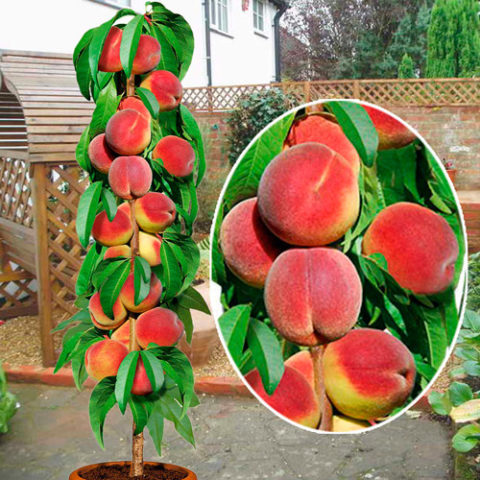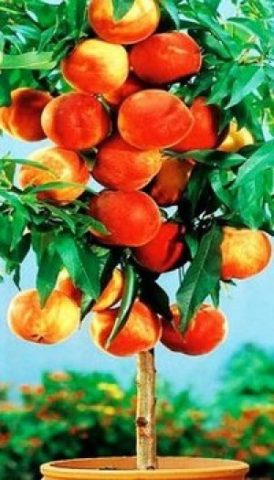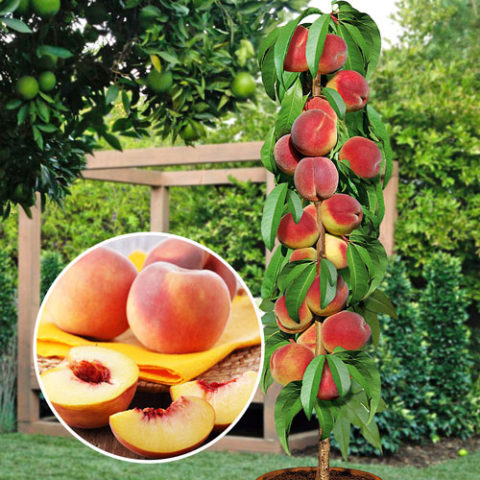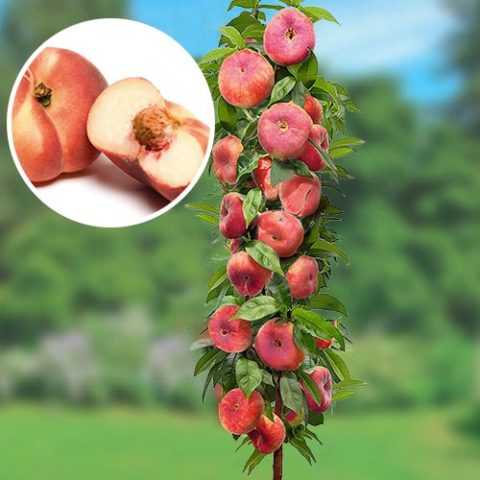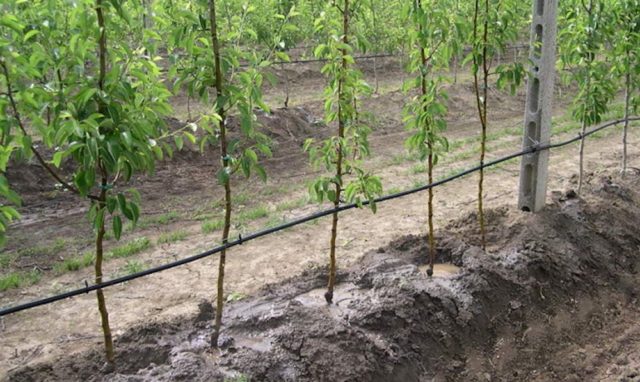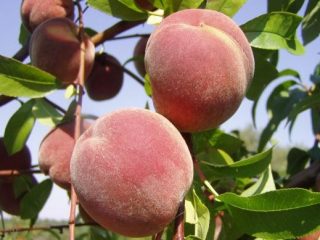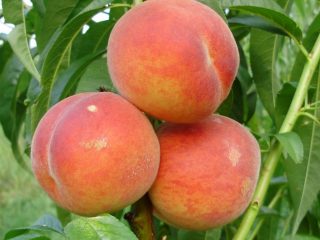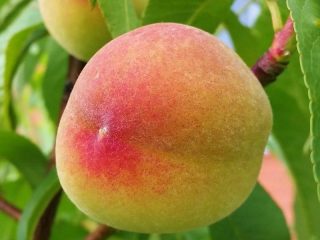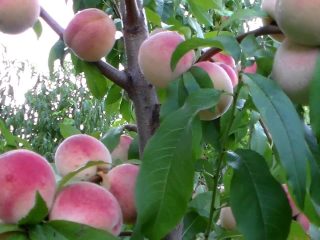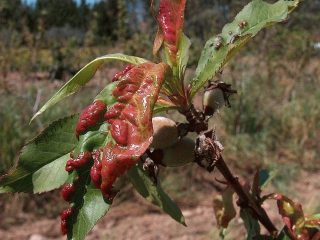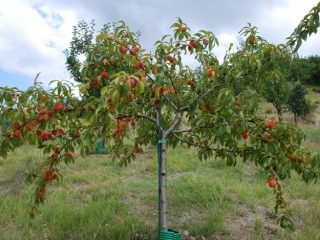Content
Columnar peach is a relatively new type of fruit tree, widely used both for decorative purposes and for harvesting. The use of columnar trees can significantly save garden space. Caring for such plants is quite simple and allows even novice gardeners to grow them.
Benefits of growing columnar peaches
Compared to regular peaches, columnar peaches have quite a few advantages. These include:
- Small size, which allows you to place quite a lot of different varieties in a small area.
- Convenience of care and harvesting.
- Disease and pest resistance.
- Early onset of fruiting.
- Good fruit taste.
- The size of the fruit is larger than usual.
- Crohn needs almost no pruning.
- High winter hardiness.
Despite the fact that the reviews about columnar peaches are very good, they are not without drawbacks. Such trees do not have a high yield due to their small size. Their lifespan is much shorter than usual.
Columnar peaches have another drawback - the high price of seedlings, reaching up to 1000 rubles per 1 piece.
General description of columnar peaches
The columnar peach gets its name from its characteristic column-like crown shape. It is a low deciduous fruit tree. Its height is usually no more than one and a half meters, although varieties with a higher crown are also found. A columnar peach is planted singly or in group plantings for decorative purposes. The plant looks very impressive both during flowering and during fruiting.
Characteristics of columnar varieties of peaches
Columnar peach varieties have increased pest and disease resistance compared to conventional trees. Due to their small size, their yield is much lower, but the fruits themselves are larger and tastier. They are more winter-hardy than ordinary ones, they can easily withstand temperatures down to -40 ° C.
In terms of flowering and fruiting, trees of this type do not differ from ordinary peaches, among them there are both early and late varieties.
Popular varieties of columnar peach
Gardener's Totem... It is one of the most popular columnar peach varieties. It is a medium-early ripening variety, usually the fruits reach maturity in the second half of July. The height of the tree does not exceed 1.7 m. The fruits are large, up to 300 g in weight, rounded. The pulp is juicy, yellow-orange in color, sweet taste. Ripe fruits have a good presentation, high transportability, are well stored. The total yield can reach 12-14 kg per tree. The gardener's totem is one of the most unpretentious varieties that are not demanding on growing conditions.
Steinberg... The variety has a pyramidal crown shape. The height of an adult tree can be up to 2 meters. Fruits are roundish, orange-yellow in color. Their average weight is 150 g. From the sunny side, a crimson blush appears on the peaches. The pulp is fragrant, juicy, yellowish.
Anniversary of the capital... The tree of this variety grows up to one and a half meters. Its fruits are bright yellow, 230–250 g in weight, sweet taste. You can use them both for fresh consumption and for canning.
Golden Triumph... An early ripening variety that ripens in early July. The average height of a tree is up to one and a half meters. The crown is compact. Fruits are red, orange pulp, sweet, aromatic. The average weight of fruits is 250-280 g. The total yield can reach 10 kg per tree. The variety is distinguished by its high resistance to diseases, as well as increased frost resistance.
Honey... It is an early variety that ripens in early July. The crown is medium in size, the height of the tree can reach 2 meters. Fruits up to 200 g, round, yellow with a characteristic blush, slightly pubescent. The taste is sweet.
Souvenir. Crimean variety of columnar peach. The tree can reach 2.5 m in height, crown with a diameter of up to half a meter. The fruits ripen rather late, in the first half of August. They are yellow in color, with a slight blush and slight pubescence. The pulp is yellow, juicy, sweet.
Varieties of columnar peaches for the Moscow region
The climate of the Moscow region is by no means ideal for such a southern culture as peach. However, the high frost resistance and disease resistance of these trees makes them possible to grow even in such conditions. Now columnar peaches grow well not only in the Moscow region, but also in more northern territories.
All the varieties described above have high winter hardiness, so they can easily tolerate winters near Moscow. In addition, you can try to grow a columnar Fig peach in the Moscow region. This is a relatively young variety. The height of the tree does not exceed 2 m. The fruits are flattened, sweet and juicy, but lie and are poorly transported due to their delicate skin. Their mass is 150-180 g.
Planting and caring for columnar peaches
For planting, annual seedlings of a columnar peach are usually used. When choosing them, you should be especially careful, taking into account their cost. The seedling should look good and have a developed root system. The columnar peach is planted in late autumn or early spring, before the start of the growing season.
Site selection and soil preparation
For good growth and development of the plant, a large amount of sunlight is needed, therefore it is advisable to choose a place on the south side of the site. It is not recommended to plant it in the shade of other trees, buildings and structures. Wetlands and low-lying areas, as well as areas with high groundwater levels, are not suitable for planting.
Preparing the soil for planting should be done in advance. The place for the future seedling is cleared by removing weeds and extra rubbish. After that, the site is dug up, I add humus or rotted manure to the soil. It is best to do this in the fall if the planting is planned in the spring. For autumn planting, the procedure should be performed at least one month before the planned landing date.
Landing algorithm
Planting holes for planting a columnar peach are dug taking into account the size of the root system of the seedling. Usually this is a hole with a diameter of about half a meter and a depth of 50-60 cm. A layer of drainage from broken bricks, crushed stone or expanded clay with a layer of 7-10 cm is laid on the bottom, then the same layer of fertile soil is poured. Near the center of the pit, you need to drive a peg to which a young tree will be tied.
The seedling is installed vertically in the pit and carefully covered with soil. It must be lightly tamped to prevent the formation of voids in the ground. Then the trunk circle must be watered abundantly with water. The planted tree must be tied to a support, this will protect it from wind damage.
Columnar peach care
Further care for columnar peaches is not difficult. During the year, it is processed to protect against diseases and pests, watering, fertilizing, loosening and mulching the soil. Watering frequency depends on the amount of precipitation. In dry weather, the trees are watered about once a week.If there is enough rainfall, watering can be done once a month or less. The tree needs to be fed several times during the season. As a rule, complex mineral fertilizers are used for this in spring and summer, and organic matter in autumn.
During the season, 2-3 wood treatments are carried out with special preparations for the prevention of diseases. Despite the fact that the columnar peach is a fairly frost-resistant plant, it must be covered for the winter. To do this, you can use various materials that allow air to pass through: burlap, paper, parchment, straw, dry reeds and others.
How to prune a columnar peach
Columnar peach pruning is done in early spring, before the start of the growing season. At this time, old diseased dry branches are removed, and the annual growth is also shortened to a length of 15-20 cm. This will allow the tree to retain its decorative appearance. In the fall, a preventive examination of the peach is done, during which damaged and dry branches are also removed.
A video on pruning the columnar peach and other columnar trees can be viewed at the link below.
Conclusion
Columnar peach is no longer a rare and ornamental plant. More and more gardeners are planting these trees on their plots, which combine both decorative purposes and harvesting functions. It is much easier to care for such trees than for ordinary ones, so they attract not only experienced, but also novice gardeners.

